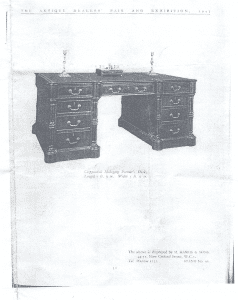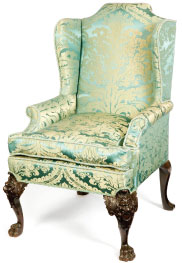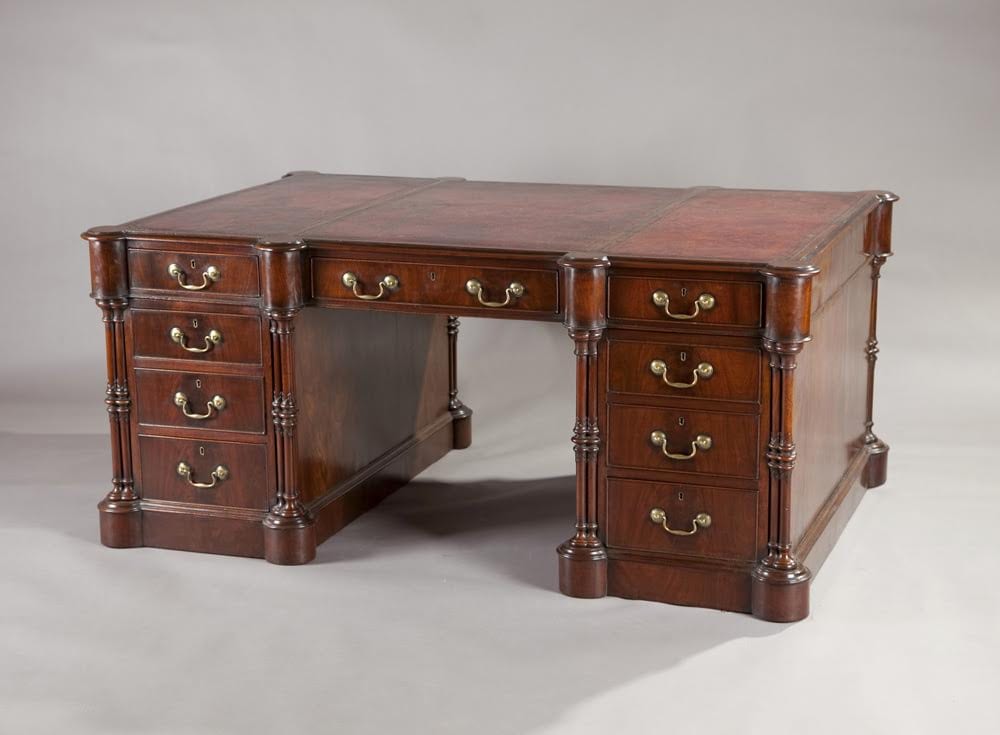The earliest form of the antique desk was a bureau, a hinged sloping front desk in which the writing surface can be opened and closed. They were an adaptation of a box or board onto which the writing slope was fitted. At first the sloping surface sat on a stand or pillar legs but soon there was a need for a purpose-made writing desk. By the 1690s the writing slope merged with a chest of drawers; antique bureau are essentially a fusion of two different types of furniture, a writing desk and a chest of drawers. They were very fashionable during the Queen Anne period.
These bureau desks were closely followed in Queen Anne (1702 – 1714) period by the kneehole-writing table. This was a small desk with drawers either side of a kneehole, which was often fitted with a central cupboard. These were either veneered in walnut or provincially constructed of oak. The bureau which developed in France from the end of the 17th Century as an alternative to the conventional triad of candlesticks, looking glass and pier table subsequently become a very popular form of the desk for a sitting-room and was made in great numbers during the 18th and 19th century alongside Georgian Regency bureau desks, library tables, flat topped writing desks and davenports.
It is not until the 1750’s that we start to see the pedestal and partners desk that has become so popular today. The 18th Century saw the availability of mahogany wood from the Caribbean islands. The wood which is richly figured and when polished and become a deep reddish brown colour was considered a luxury item and popularised by designers such as Thomas Chippendale, William Vile, John Syers, Gillows of London and Lancaster, Holland and Son and John McLean who were working for wealthy patrons.
This antique desk style, popular from the late 1800s through the early 1900s, is said to have originated in England. Two-sided desks such as these were often used by lawyers, bankers and businessmen who wished to work together for convenience. They are the same on each side allowing individuals to face one another. Since they are essentially office furniture, they are usually heavy and well-made from quality woods such as mahogany or oak. Consequently, most desks, which survive from the mid-18th century, were made for the country house library. They are often large, ornate, with carved embellishments, often with leather tops and command substantial prices due to their rarity. The choices of woods used in combination with the precise construction and exceptional carving, inlay and metal work ensure that the desk forms the focal point of a room and has always been considered with distinction.
I have enclosed images of a very rare desk in our collection and the accompanying catalogue form The Grosvenor House Art and Antiques Fair in which it was exhibited. This fine early 19th century George III mahogany pedestal partners desk with leather inset top raised above outset corners and cluster columns, each plinth with three drawers and an opposing cupboard door supported on plinth base.
Provenance: Mourne Park House

The desk was exhibited in the ‘The Grosvenor House Art and Antiques Fair, London’, an exhibition which was running annually from 1934 – 2009 up to the war and resumed in 1947, it was in this year that the partners desk was exhibited. The Fair had no less than thirty-eight Royal openings and a distinctive feature of the Fair for many years was the loan of treasures, not ordinarily on view, from the collections of Her Majesty The Queen, The Queen Mother and other members of the Royal Family.

The only fair with Royal patronage this event would have consequences for a greater appreciation and access to antiques by a wider public in the years to come. You will see pictured below an image from the catalogue along with the image of the desk.
This desk was held in the private collection of Mourne Park House, Kilkeel, County Down, the family residence of the Needham Family. It was originally built in the early 19th Century as a two story building by Robert Needham, 11th Viscount Kilmorey. A third story was added sometime after 1820 and more extensions followed in 1859. It was listed as a ‘Gentleman’s Seat’ in 1812.
Please view at your leisure our desk collection and many other fine antiques on our website in both our Dublin store and New York gallery.

